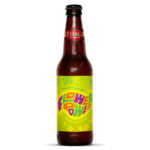When you think of brandy, it’s hard not to think of an old man in an armchair, swilling his glass while simultaneously smoking a cigar. In Waco, Texas, there’s another man who wants us to leave this image behind, as he aims to start a new Texas brandy tradition. The man in question is Chip Tate. And while anyone could make such an ambitious statement, when Tate talks about craft distilling you’d be wise to listen.
It is whiskey, not brandy, with which Tate is associated and received worldwide recognition for at his first distillery, Balcones. Among the 140 awards he amassed during a six year period starting in 2008, were Wizards of Whiskey’s prestigious duo ‘World Single Malt of the Year’ and ‘World Whiskey of the Year’.
In 2014, relations between Tate and investors in Balcones turned sour. The investors, incorporated into the business in 2013 and chosen by Tate for their “commitment to quality over quick return,” were unhappy with the spiraling costs of work on a planned new distillery. At the same time, Tate felt like the investors and company board were trying to force him out and a much publicized legal battle for control of the company ensued.
Realizing that relations were beyond repair, Tate decided to sell his stake in Balcones and use the capital generated to set up a new distillery. Tate & Co was founded at the end of 2014. Part of the legal settlement blocked Tate from producing whiskey until March 2016. While he one day aims to build on his success with single malt, for now at least, Tate & Co is instead focusing on brandy.
The world’s most renowned brandies are Cognac and Armagnac, both regions in France. As with French wine, there are many complex regulations that producers must follow, if they wish to use the appellation of the area where they produce their brandy. The overall process, however, is always the same.
Brandy is a liquor distilled from fermented fruit juice, typically grapes. When a producer decides to use a different fruit base, the end product is a ‘Fruit Brandy’. After distillation the liquor is aged in oak casks for a determined amount of time, before being bottled and sold.


Though we tend to think of Brandy as a French liquor, it is actually thanks to an American that we are able to enjoy it today. Viticulturist T.V. Munson, who lived in Denison, Texas, helped save the French wine (and in turn brandy) industry from the root-eating phylloxera pest in the 1880’s. His research enabled European vines to be grafted onto Texan phylloxera-resistant roots and saved the continent from a devastating epidemic. In recognition of his work, the French government bestowed upon him the ‘Order of Agricultural Merit’ and Denison remains the sister city of Cognac to this day.
In April 2015, Tate flew to Cognac where he spent time with cellar master Baptiste Loiseau of Remy Martin. Here, he experienced the traditional ‘pot still’ distillation process of Cognac first hand and he and Loiseau shared opinions and ideas about the art of blending spirits.
Upon his return to the United States, Tate started formulating his unique method of producing brandy. While he decided that he would distill wine and then age it in wooden barrels, it is here that similarities between Tate & Co’s brandy and Cognac and Armagnac end.
Years earlier, while studying physics at university, Tate had a quantum professor that pointed out that the majority of his questions were philosophical rather than scientific. “I think that mental pursuit of thinking about the whys of things definitely shaped my approach to distilling” Tate reflects. Rather than simply study what was being done in Cognac and then take it to Texas, Tate instead decided that he could improve on the 500 year-old practice.
The stills used at Tate & Co are of Tate’s very own custom design as well as being hand built by him in the distillery. They are “a lot more like whiskey stills than traditional cognac stills” Tate reveals coyly, though further details of their unique design remains a closely guarded secret at the distillery.
Barrels used for aging are selected for the flavors they impart on the spirit, rather than their origin. Tate & Co ages its brandy in a mixture of ex-whiskey barrels and new barrels made to his unique specifications. The aging process Tate articulately describes as “schooling the spirit through multiple teachers” and indeed all eventual spirits produced by Tate & Co will receive this particular education. All brandy produced will age for a minimum of two years, as is required by U.S. law.
With no existing brandy tradition in Texas, the Ugni Blanc grape variety used in Cognac and Armagnac is not grown. Ugni Blanc produces very average table wine and even though Texas is the second largest producer of grapes in the United States, almost all are grown to produce wine.
At Tate & Co, they plan to use grapes more commonly found in wine to produce their brandy; Zinfandel was used to produce their first batch. Tate describes himself as a “pragmatic localist” preferring to use local produce rather than imports, especially when the produce at hand is “interesting and of good quality.”
One final factor bound to have a profound effect on the brandy at Tate & Co is its “unique aging environment.” The “blistering hot in the summer and hot-cold hot-cold in the winter” resulting in increased micro-oxygenation and evaporation within the barrels. In turn, Tate & Co’s brandy will age faster and less subtly than the way in which Armagnac and Cognac do.


Tate & Co’s first batch of brandy was distilled at Ironroot Republic, another Texan distillery. The process involved in hand-building 6 custom-design copper stills is a lengthy one and one that could not be completed in time for the 2015 Texan grape harvesting season. This, combined with the fact that Tate had invested all of the proceeds from the court settlement into his new distillery, meant that work on the brandy — which would then need to be aged — had to begin as soon as possible.
Robert Likarish, co-owner of Ironroot, is a friend of Tate’s. He is also in the process of developing a Texan Brandy, though this didn’t stop him from helping out a potential rival. Clearly the interest that someone with Tate’s reputation will attract is one that could benefit all involved in the production of Texas Brandy.
What is it then, that we should expect from a Texan brandy? And in particular Tate & Co’s first offering; “I wouldn’t be shocked if people said ‘yeah this is what you get when a whiskey maker makes brandy’ and I wouldn’t take it as an insult.” says Tate. The “full, rich, rounded flavors” producing a brandy more akin to whiskey than Cognac in it’s viscosity. The grape varieties and aging conditions mentioned sure to result in something intentionally more bold and Texan than the classical French counterpart. Think Beyoncé vs Édith Piaf.
Tate expects the flavor to further improve by the time it goes on sale in the fall of 2017 and a bottle should cost between $20 – $30. Tate & Co’s brandy appears deliberately priced to fill a current gap in the US brandy market between high-end brandy and entry-level cognac. Referred to as ‘the brandy gap’ it is thought by some to be worth as much as $1 billion. If one were hoping to start a “brandy tradition” now, it seems, would be a good time.
While we wait and see what Tate & Co has to offer, it’s difficult to ignore how fitting it would be, if, in the state that saved brandy for the world, a new “brandy tradition” was born. Tate’s brandy promises to be unique and, judging by past experience, a success. Only time will tell how big an impact he, his neighbors at Ironroot Republic and other Texan distilleries eager for their share of ‘the brandy gap’ can have on the international market.
















